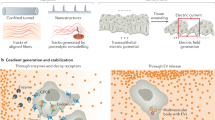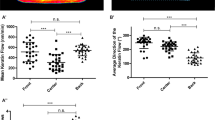Abstract
Human keratinocytes actively crawl in vitro when plated onto a collagen-coated glass substrate, and their direction of migration is totally random. In response to an imposed dc electric field, they migrate asymmetrically, moving mostly toward the negative pole of the field. The authors have analyzed experimental data reported by others to determine the basic characteristics of the cellular response machinery in these keratinocytes. This movement can be completely described mathematically using two independent variables: the speed, V, and the angle of migration, ϕ. The authors propose a model in which a steerer (controller without feedback) is responsible for determining the speed, and an automatic controller (controller with feedback) is responsible for determining the angle of migration. The torque to rotate is induced by a deterministic cellular signal and a stochastic cellular signal. The cellular machine characteristics are determined as follows: The angular dependence of the detection unit is sin ϕ; the detection unit detects the guiding field in a linear fashion; the cellular reaction unit can be described by a constant; the chemical amplifier, as well as the cellular motor work, is linear; the cellular characteristic time, which quantifies the cellular stochastic signal, is 50 min.
Similar content being viewed by others
References
Nuccitelli, R. (1988) Physiological electric fields can influence cell motility, growth, and polarity. Adv. Cell Biol. 2, 213–233.
Wiener, N. (1961) Cybernetics: or Control and Communication in Animal and Machine, MIT Press, Cambridge, MA.
Gruler, H. and Gow, N. A. (1990) Directed growth of fungal hyphae in an electric field. Z. Naturforsch. 45c, 306–313.
Nishimura, K. Y., Isseroff, R. R., and Nuccitelli, R. (1996) Human keratinocytes migrate to the negative pole in direct current electric fields comparable to those measured in mammalian wounds. J. Cell Sci. 109, 199–207.
Sheridan, D. M., Isseroff, R. R., and Nuccitelli, R. (1996) Imposition of a physiologic DC electric field alters the migratory response of human keratinocytes on extracellular matrix molecules. J. Invest. Dermatol. 106, 642–646.
Erickson, C. A. and Nuccitelli, R. (1984) Embryonic fibroblast motility and orientation can be influenced by physiological fields. J. Cell Biol. 98, 296–307.
Gruler, H. and Nuccitelli, R. (1986) New insights into galvanotaxis and other directed cell movements: an analysis of the translocation distribution function, in Ionic Currents in Development, Nuccitelli, R. ed., Alan R. Liss, New York, 337–347.
Haken, H. (1983) Synergetics, Nonequilibrium Phase Transitions and Self-Organization in Physics, Chemistry and Biology, Springer, Heidelberg.
Schienbein, M. and Gruler, H. (1994) Langevin equation, Fokker-Planck equation and cell migration. Bull. Math. Biol. 55, 585–608.
Gruler, H. (1998). Fluid self-organized machines. Liquid Crystal 24, 49–66.
Malawista, S. E. and de Boisfleury Chevance, A. (1982) The cytokineplast: purified, stable, and functional motile machinery from human blood polymorphonuclear leukocytes. Possible formation role of heat-induced centrosomal dysfunction. J. Cell Biol. 95, 960–973.
Risken, H. (1984) The Fokker-Planck Equation, Springer-Verlag, Heidelberg.
Gruler, H. and Nuccitelli, R. (1991) Neural crest cell galvanotaxis: new data and a novel approach to the analysis of both galvanotaxis and chemotaxis. Cell Motil. Cytoskelet. 19, 121–133.
de Boisfleury-Chevance, A., Rapp, B., and Gruler, H. (1989) Locomotion of white blood cells: a biophysical analysis. Blood Cells 15, 315–333.
Barker, A. T., Jaffe, L. F., and Vanable, J. W., Jr. (1982) The glabrous epidermis of cavies contains a powerful battery. Am. J. Physiol. 242, R358-R366.
Schienbein, M., Franke, K., and Gruler, H. (1994) Random walk and directed movement: comparison between inert particles and self-organized molecular machines. Phys. Rev. E. 49, 5492–5471.
Gruler, H. (1995) New insights into directed cell migration: characteristics and mechanisms. Nouv. Rev. Fr. Hematol. 37, 255–265.
Wymann, M. P., Kernen, P., Bengtsson, T., Andersson, T., Baggiolini, M., and Deranleau, D. A. (1990) Corresponding oscillations in neutrophil shape and filamentous actin content. J. Biol. Chem. 265, 619–622.
Jäger, U., Gruler, H., and Bültmann, B. D. (1988) Morphological changes and membrane potential of human granulocytes under influence of chemotactic peptide and/or echo-virus, type 9. Klin Wochenschr. 66, 434–436.
Petty, H. R. (2000) Metabolic signaling and cellular oscillations during neutrophil migration and induction of metabolic resonance by electric fields, in Self-Organized Biological Dynamics and Nonlinear Control: Toward Understanding Complexity Chaos, and Emergent Function in Living systems. (Walleczek J., ed.,) Cambridge University Press, Cambridge, UK.
Vereycken, V., Gruler, H., Bucherer, C., Lacombe, C., and Lelièvre, J. C. (1995) The linear motor in the human neutrophil migation. J. Phys. III France 5, 1469–1480.
Constant, E., LeNegrate, A., and deBoisfleury-Chevance, A. (1993) Visualization of intracellular calcium during necrotaxis. Blood Cells 19, 43–52.
Franke, K. and Gruler, H. (1994) Directed cell migration in pulsed electric fields. Z. Naturforsch. 49c, 241–249.
Gruler, H. (1991) Cell movement and automatic control, in Biologically Inspired Physics (Peliti, L., ed.), Plenum, New York. 217–227.
Gruler, H. (1990) Chemokinesis, chemotaxis, and galvanotaxis. Dose-response curves and signal chain, in Biological Motion, (Alt, W. and Hoffmann, G., ed.), Springer Verlag, Heidelberg, 396–414.
Author information
Authors and Affiliations
Corresponding author
Rights and permissions
About this article
Cite this article
Gruler, H., Nuccitelli, R. The galvanotaxis response mechanism of keratinocytes can be modeled as a proportional controller. Cell Biochem Biophys 33, 33–51 (2000). https://doi.org/10.1385/CBB:33:1:33
Issue Date:
DOI: https://doi.org/10.1385/CBB:33:1:33




